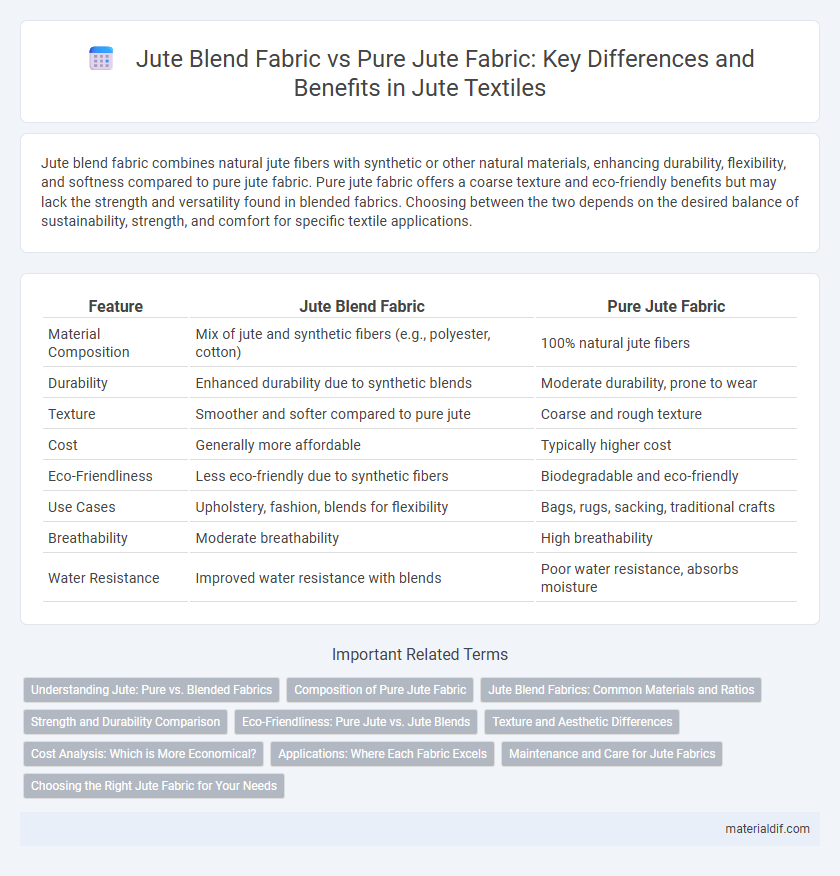Jute blend fabric combines natural jute fibers with synthetic or other natural materials, enhancing durability, flexibility, and softness compared to pure jute fabric. Pure jute fabric offers a coarse texture and eco-friendly benefits but may lack the strength and versatility found in blended fabrics. Choosing between the two depends on the desired balance of sustainability, strength, and comfort for specific textile applications.
Table of Comparison
| Feature | Jute Blend Fabric | Pure Jute Fabric |
|---|---|---|
| Material Composition | Mix of jute and synthetic fibers (e.g., polyester, cotton) | 100% natural jute fibers |
| Durability | Enhanced durability due to synthetic blends | Moderate durability, prone to wear |
| Texture | Smoother and softer compared to pure jute | Coarse and rough texture |
| Cost | Generally more affordable | Typically higher cost |
| Eco-Friendliness | Less eco-friendly due to synthetic fibers | Biodegradable and eco-friendly |
| Use Cases | Upholstery, fashion, blends for flexibility | Bags, rugs, sacking, traditional crafts |
| Breathability | Moderate breathability | High breathability |
| Water Resistance | Improved water resistance with blends | Poor water resistance, absorbs moisture |
Understanding Jute: Pure vs. Blended Fabrics
Pure jute fabric consists entirely of natural jute fibers, offering exceptional biodegradability, breathability, and a coarse texture ideal for eco-friendly products and packaging. Jute blend fabric combines jute with synthetic or other natural fibers, enhancing durability, flexibility, and resistance to wrinkles and shrinkage while maintaining some of jute's sustainable qualities. Choosing between pure and blended jute fabrics depends on the intended use, balancing environmental impact with performance requirements.
Composition of Pure Jute Fabric
Pure jute fabric consists entirely of natural jute fibers derived from the Corchorus plant, offering high tensile strength and coarse texture ideal for eco-friendly packaging and home textiles. Unlike jute blends, pure jute fabric maintains excellent breathability, moisture absorption, and biodegradability without synthetic additives. The 100% natural composition ensures superior sustainability, durability, and traditional appeal in applications requiring strong, rustic material properties.
Jute Blend Fabrics: Common Materials and Ratios
Jute blend fabrics commonly combine jute fibers with cotton, polyester, or silk to enhance durability and texture, with typical ratios ranging from 50:50 to 70:30 depending on the desired fabric strength and softness. Blends featuring 60% jute and 40% cotton offer improved breathability and flexibility, while polyester-jute blends in a 65:35 ratio provide superior wrinkle resistance and color retention. These material combinations optimize the natural aesthetic of jute while addressing limitations like stiffness and moisture absorption.
Strength and Durability Comparison
Jute blend fabric combines natural jute fibers with synthetic materials, resulting in enhanced strength and improved durability compared to pure jute fabric. Pure jute fabric, while biodegradable and eco-friendly, tends to be more susceptible to wear, moisture damage, and tearing under heavy use. The synergy of synthetic fibers in jute blends increases tensile strength and resistance to abrasion, making it more suitable for applications requiring long-lasting performance.
Eco-Friendliness: Pure Jute vs. Jute Blends
Pure jute fabric is highly eco-friendly due to its 100% natural fiber composition, biodegradability, and minimal chemical processing, which significantly reduce environmental impact. Jute blend fabrics, while still sustainable, incorporate synthetic fibers that may hinder biodegradability and increase the carbon footprint during manufacturing. Choosing pure jute supports eco-conscious practices by promoting renewable resources and reducing synthetic waste.
Texture and Aesthetic Differences
Jute blend fabric combines natural jute fibers with materials like cotton or polyester, resulting in a softer texture and enhanced durability compared to pure jute fabric, which is coarser and more rigid. The aesthetic appeal of jute blend fabric is smoother and more refined, making it suitable for apparel and home textiles, while pure jute fabric retains a rustic, natural look favored in eco-friendly bags and rugs. Texture-wise, the blend offers increased flexibility and reduced roughness, appealing to consumers seeking comfort alongside sustainable design.
Cost Analysis: Which is More Economical?
Jute blend fabric offers a cost advantage over pure jute fabric due to its mixed composition, which reduces manufacturing expenses and lowers raw material costs. Pure jute fabric typically involves higher production costs because of its 100% natural fiber content and minimal processing. For budget-conscious buyers, jute blend fabric provides more economical pricing without significantly compromising durability and texture.
Applications: Where Each Fabric Excels
Jute blend fabric excels in home decor and fashion applications due to its enhanced durability and softer texture, making it ideal for upholstery, bags, and apparel. Pure jute fabric is preferred in industrial and agricultural uses such as sacks, ropes, and mats because of its strength, breathability, and biodegradability. Each fabric's unique composition directly influences its suitability for either decorative or functional purposes.
Maintenance and Care for Jute Fabrics
Jute blend fabric requires less intensive maintenance compared to pure jute fabric, as the blended fibers enhance durability and reduce brittleness. Pure jute fabric demands careful handling to prevent moisture damage and frequent cleaning to avoid fiber weakening from dirt accumulation. Both fabrics benefit from air drying and storage in dry, ventilated areas to maintain longevity and prevent mold growth.
Choosing the Right Jute Fabric for Your Needs
Jute blend fabric combines natural jute fibers with other materials like cotton or polyester, enhancing durability, softness, and resistance to wear compared to pure jute fabric, which offers maximum eco-friendliness and a coarse texture ideal for rustic designs. Choosing the right jute fabric depends on the intended use: pure jute suits biodegradable packaging and decor emphasizing sustainability, while jute blends are preferred for upholstery and fashion where strength and comfort are priorities. Understanding the blend ratio and fabric treatment helps optimize performance for specific applications such as bags, rugs, or home furnishings.
Jute Blend Fabric vs Pure Jute Fabric Infographic

 materialdif.com
materialdif.com